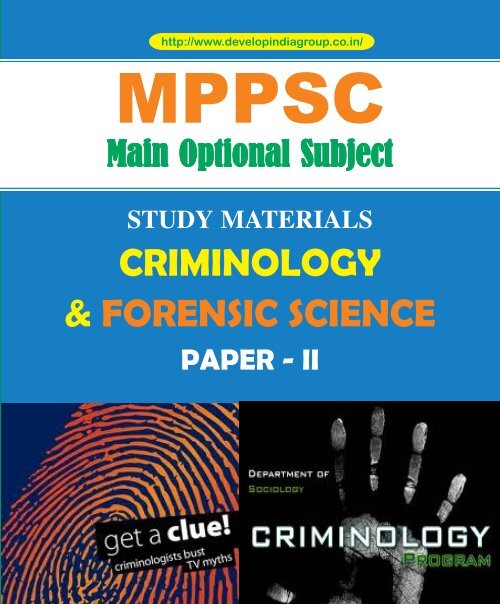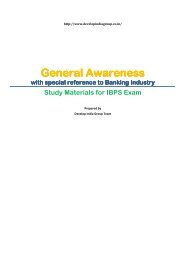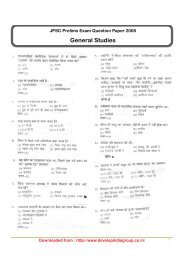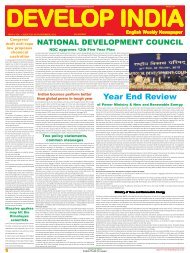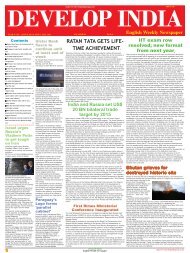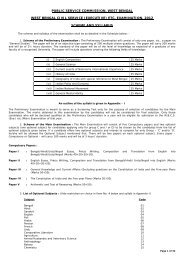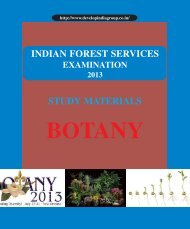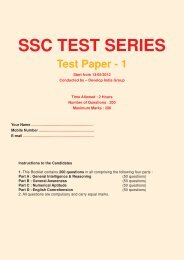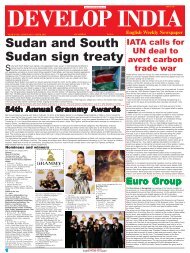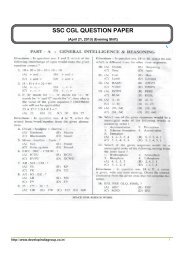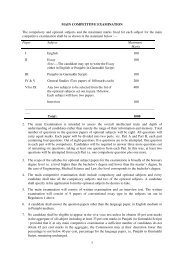MPPSC Criminology Paper II Sample 1-5 Pages.pdf
MPPSC Criminology Paper II Sample 1-5 Pages.pdf
MPPSC Criminology Paper II Sample 1-5 Pages.pdf
- No tags were found...
Create successful ePaper yourself
Turn your PDF publications into a flip-book with our unique Google optimized e-Paper software.
http://www.developindiagroup.co.in/<strong>MPPSC</strong>Main Optional SubjectSTUDY MATERIALSCRIMINOLOGY& FORENSIC SCIENCEPAPER - <strong>II</strong>Published ByDEVELOP INDIA GROUP
<strong>MPPSC</strong> Main Optional - CRIMINOLOGY AND FORENSIC SCIENCE (PAPER - <strong>II</strong>)Content1. Fingerprints - Patterns and types, development, lifting,preservation and comparison 4World's Largest Database 4Types 5Fingerprint Classification 6Fingerprint collection and preservation 72. Foot and foot-wear prints - Importance, gait-pattern, preservation,lifting, casting and comparison 93. Tyre and track marks - Importance, preservation and comparison19204. Questioned documents Types and examination, procurementof control samples, alterations, charred documents,Fingerprints 24http://www.developindiagroup.co.in/Bite Marks 24Broken Fingernails 25Questioned Documents 25Blood and Body Fluids 25Firearms and Toolmarks 25Shoeprints and Tire Tracks 26Fracture Matches 26Hair 26Fibers 26Paint 26Glass 26Other Trace Evidence 26CASES IN WHICH NO EXEMPLARS ARE NEEDED 27REQUEST WRITING 27DOs AND DON'Ts FOR COLLECTING EXEMPLARS AND STAN-DARDS 275. Firearms in criminal activities, classification, componentsof firearms, smooth-bore and rifled firearms, types andstructure of cartridge, preservation and forensic examina-Impression Evidence -- Footprints, Tire Tread and Tool Marks tion of firearm, bullet and shell case. Gunshot residues, estimationof range of firing 28Improvisation with other items 29Cryptic firearms 29class and individual characteristics of hand-writing, typed,printed and photo-stat matters and their comparison, indentedwriting and its development, disguised writing, sealRepeating and automatic designspreservation and forensic examination of firearmTool marks – Type, Identification and Comparative Study292930and rubber stamp 21 6. Poisons and toxicology - Definition, classification, typesDISADVANTAGES OF REQUEST WRITING SAMPLES 22 of poisoning, visceral samples for toxicological examinations,COLLECTING INFORMAL EXEMPLARS 22 isolation and clean-up procedures, analysis of opiates, cannabis,HOW MANY SAMPLES OF HANDWRITING ARE NEEDED? 23dhatura, nux-vomica, ethyl alcohol, barbiturates in-SUITABLE EXEMPLARS 23 secticides, arsenic, mercury, lead and zinc 30Collection and Preservation of Evidence 24 Poisons 30Classification Poisons 30Specific 30Weapon 31Approach 31Analysis of Following Poisions 31opiates 31cannabis 32dhatura 32nux-vomica 33ethyl alcohol 33http://www.developindiagroup.co.in/Page No. 2
<strong>MPPSC</strong> Main Optional - CRIMINOLOGY AND FORENSIC SCIENCE (PAPER - <strong>II</strong>)barbiturates insecticides 34arsenic 35mercury 35lead 36zinc 36Toxicology 37Definition and Scope 37Classification of Toxicology 387. Composition and analysis of blood, semen, saliva, urineand hair 40DNA Analysis 428. Composition and analysis of fibre, glass, paint, soil andcement 509. Forensic evidence on clothes, bed linen, curtain & towel 5210. Death investigation - Types of death, medico-legal causes,determination of sex & age, post mortem procedure, postmortem changes 5311. Wounds - Types and chacteristics, ante mortem and postmortem wounds 5512. Scientific investigation of un natural deaths (accidental,suicidal and homicidal), sexual offences, arson and explosivecases 56Sexual offences 57ARSON 62EXPLOSIVES 6313. D.N.A. Profiling - Structure of D.N.A, D.N.A. as marker,methods of D.N.A. profiling, forensic applications 6514. Polygraphy, narco-analysis and brain mapping as an investigatingaids 66Narco-analysis 68Brain-mapping 68http://www.developindiagroup.co.in/http://www.developindiagroup.co.in/Page No. 3
<strong>MPPSC</strong> Main Optional - CRIMINOLOGY AND FORENSIC SCIENCE (PAPER - <strong>II</strong>)<strong>Criminology</strong> & Forensic SciencePAPER – <strong>II</strong>1. Fingerprints - Patterns and types,development, lifting, preservationand comparisonFingerprints offer an infallible means of personal identification.Fingerprints are the traces of an impression fromthe friction ridges of any part of a human or other primatehand. A print from the foot can also leave an impressionof friction ridges. A friction ridge is a raised portion of the epidermis on the digits (fingers andtoes), the palm of the hand or the sole of the foot, consistingof one or more connected ridge units of frictionridge skin. These are sometimes known as "epidermalridges" which are caused by the underlying interfacebetween the dermal papillae of the dermis and theinterpapillary (rete) pegs of the epidermis. These epidermalridges serve to amplify vibrations triggered, forexample, when fingertips brush across an uneven surface,better transmitting the signals to sensory nervesinvolved in fine texture perception. These ridges may alsoassist in gripping rough surfaces and may improve surfacecontact in wet conditionsThe science of fingerprint Identification stands outamong all other forensic sciences for many reasons, includingthe following:Has served governments worldwide for over 100 yearsto provide accurate identification of criminals. No twofingerprints have ever been found alike in many billionsof human and automated computer comparisons. Fingerprintsare the very basis for criminal history foundationat every police agency on earth.Established the first forensic professional organization,the International Association for Identification (IAI), in1915.Established the first professional certification programfor forensic scientists, the IAI's Certified Latent Print Examiner(CLPE) program (in 1977), issuing certification tothose meeting stringent criteria and revoking certificationfor serious errors such as erroneous identifications.World's Largest DatabaseAs of February 2013, the Unique Identification Authorityof India operates the world's largest fingerprint(multi-modal biometric) system, with over 200 millionfingerprint, face and iris biometric records. UIAI plansto collect as many as 600 million multi-modal record bythe end of 2014. India's Unique Identification project isalso known as Aadhaar, a word meaning "the foundation"in several Indian languages. Aadhaar is a voluntaryprogram, with the ambitious goal of eventually providingreliable national ID documents for most of India's1.2 billion residents.With a database many times larger than any other inthe world, Aadhaar's ability to leverage automated fingerprintand iris modalities (and potentially automatedface recognition) enables rapid and reliable automatedsearching and identification impossible to accomplishwith fingerprint technology alone, especially whensearching children and elderly residents' fingerprints.Remains the most commonly used forensic evidenceworldwide - in most jurisdictions fingerprint examinationcases match or outnumber all other forensic examinationcasework combined.Continues to expand as the premier method for positivelyidentifying persons, with tens of thousands of personsadded to fingerprint repositories daily in America alone- far outdistancing similar databases in growth.Worldwide, fingerprints harvested from crime "sceneslead to more suspects and generate more evidence incourt than all other forensic laboratory techniques combined."Other visible human characteristics tend to change - fingerprintsdo not. Barring injuries or surgery causing deepscarring, or diseases such as leprosy damaging the formativelayers of friction ridge skin (injuries, scarring anddiseases tend to exhibit telltale indicators of unnaturalchange), finger and palm print features have never beenshown to move about or change their unit relationshiphttp://www.developindiagroup.co.in/http://www.developindiagroup.co.in/Page No. 4
<strong>MPPSC</strong> Main Optional - CRIMINOLOGY AND FORENSIC SCIENCE (PAPER - <strong>II</strong>)throughout the life of a person.In earlier civilizations, branding and even maiming wereused to mark the criminal for what he or she was. Thethief was deprived of the hand which committed thethievery. Ancient Romans employed the tattoo needleto identify and prevent desertion of mercenary soldiersfrom their ranks.Before the mid-1800s, law enforcement officers withextraordinary visual memories, so-called "camera eyes,"identified previously arrested offenders by sight. Photographylessened the burden on memory but was notthe answer to the criminal identification problem. Personalappearances change.Around 1870, French anthropologist Alphonse Bertillondevised a system to measure and record the dimensionsof certain bony parts of the body. These measurementswere reduced to a formula which, theoretically, wouldapply only to one person and would not change duringhis/her adult life.The Bertillon System was generally accepted for thirtyyears. But it never recovered from the events of 1903,when a man named Will West was sentenced to the U.S.Penitentiary at Leavenworth, Kansas. It was discoveredthat there was already a prisoner at the penitentiary atthe time, whose Bertillon measurements were nearly thesame, and his name was William West.Upon investigation, there were indeed two men wholooked exactly alike. Their names were Will and WilliamWest respectively. Their Bertillon measurements wereclose enough to identify them as the same person. However,a fingerprint comparison quickly and correctly identifiedthem as two different people. (Per prison recordsdiscovered later, the West men were apparently identicaltwin brothers and each had a record of correspondencewith the same immediate family relatives.)Typeshttp://www.developindiagroup.co.in/ExemplarExemplar prints, or known prints, is the name given tofingerprints deliberately collected from a subject,whether for purposes of enrollment in a system or whenunder arrest for a suspected criminal offense. Duringcriminal arrests, a set of exemplar prints will normallyinclude one print taken from each finger that has beenrolled from one edge of the nail to the other, plain (orslap) impressions of each of the four fingers of each hand,and plain impressions of each thumb. Exemplar printscan be collected using Live Scan or by using ink on papercards.LatentAlthough the word latent means hidden or invisible, inmodern usage for forensic science the term latent printsmeans any chance or accidental impression left by frictionridge skin on a surface, regardless of whether it isvisible or invisible at the time of deposition. Electronic,chemical and physical processing techniques permit visualizationof invisible latent print residues whether theyare from natural sweat on the skin or from a contaminantsuch as motor oil, blood, ink, paint or some otherform of dirt. The different types of fingerprint patterns,such as arch, loop and whorl, will be described below.Latent prints may exhibit only a small portion of the surfaceof a finger and this may be smudged, distorted, overlappedby other prints from the same or from differentindividuals, or any or all of these in combination. For thisreason, latent prints usually present an “inevitable sourceof error in making comparisons,” as they generally “containless clarity, less content, and less undistorted informationthan a fingerprint taken under controlled conditions,and much, much less detail compared to the actualpatterns of ridges and grooves of a finger.PatentPatent prints are chance friction ridge impressions whichare obvious to the human eye and which have beencaused by the transfer of foreign material from a fingeronto a surface. Some obvious examples would be impressionsfrom flour and wet clay. Because they are alreadyvisible and have no need of enhancement they aregenerally photographed rather than being lifted in theway that latent prints are. An attempt to preserve theactual print is always made for later presentation in court,and there are many techniques used to do this. Patentprints can be left on a surface by materials such as ink,dirt, or blood.PlasticA plastic print is a friction ridge impression left in a materialthat retains the shape of the ridge detail. Althoughvery few criminals would be careless enough to leavehttp://www.developindiagroup.co.in/Page No. 5


